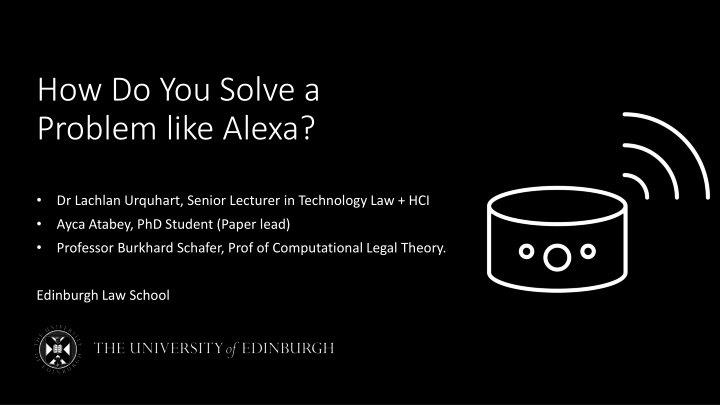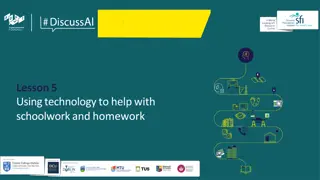
Empowering Emotional AI in Everyday Life with Alexa and Affective Computing
Delve into how emotional AI and affective computing, exemplified by Alexa, can enhance daily interactions by analyzing and responding to emotional cues. Explore the ethical considerations, regulatory challenges, and the EU's risk-based approach to AI regulation. Discover the multifunctional capabilities of Alexa, bridging music, emotions, and human-like conversational skills in various contexts.
Download Presentation

Please find below an Image/Link to download the presentation.
The content on the website is provided AS IS for your information and personal use only. It may not be sold, licensed, or shared on other websites without obtaining consent from the author. If you encounter any issues during the download, it is possible that the publisher has removed the file from their server.
You are allowed to download the files provided on this website for personal or commercial use, subject to the condition that they are used lawfully. All files are the property of their respective owners.
The content on the website is provided AS IS for your information and personal use only. It may not be sold, licensed, or shared on other websites without obtaining consent from the author.
E N D
Presentation Transcript
How Do You Solve a Problem like Alexa? Dr Lachlan Urquhart, Senior Lecturer in Technology Law + HCI Ayca Atabey, PhD Student (Paper lead) Professor Burkhard Schafer, Prof of Computational Legal Theory. Edinburgh Law School
Consider the following scenario: Imagine coming home from work after a long day of work, slightly stressed. Upon arriving home, your daughter is playing music you do not like loudly from the living room. You tell the smart speaker to stop the music which prompts your daughter to shout at you and go to her room. Your younger daughter is upset by this and starts crying. Alexa analyses the stress level in the three voices in this domestic drama, and developed models of their states. In response Alexa chooses 3 different pieces of music, one each to sooth the upset of each family member after this fight.
Emotional AI / Affective Computing Emotion recognition technologies - seeks to read and infer about emotional life. On and off body sensing examples e.g. wearables for heart rate, skin response to computer vision on facial features. Ekman s Universal underpinning universal basic emotion model (cross cultural; 6 basic emotions). Criticised (focus on deception; Can emotion ever be computationally read from body in first place? Regulatory uncertainty around these systems Concerns from regulators calls for - EDPS/EDPB/UK ICO Now shift to reading through voice too.
Concerns about Emotional AI Loss of emotional ephemerality emotion datafied, catalogued, assessed Manipulation new vector to nudge, persuade for advertising, dark design practices? dynamic advertising . Resistance Strategies unsure how being read? How to mask voice? Impact on Identity space for formulation of identity in family home with speaker listening Uncertainty decisions based on emotional sorting (can we contest? Do we know how we feel? What is baseline truth here
The AIA and its risk-based approach The EU approach to regulating AI is technologically neutral and risk-based . The AIA focuses on contexts of use and application of AI systems, not based on autonomy, say. EAI in law enforcement is high risk or in safety critical monitoring of driving Other contexts is low risk (e.g. gaming) Could dismiss as low risk (just change song if dislike it) but unclear? Emotional AI with Music could be deemed more innocent, but equally, due to music factor, could have greater risk implications for individuals and society and be classified only as low-risk by AIA?
Why Alexa? Cross-sectoral and multifunctional uses linking music, life and motions. Human-like conversation abilities. Alexa as IoT Device links together Amazon suite devices and third parties e.g. Health bands. Alexa as Music Recommender Systems - across devices (e.g. smart home screens); links into third party vendors e.g. Spotify and social network e.g. sharing music with contact lists. Match music to activity (e.g., cooking, workout) insights into contexts of use and everyday life.
Alexa Neural Text to Speech (NTTS) Patented Alexa Neural Text to Speech (NTTS) technology. - Targeting users voices to infer emotions using AI based biometric recognition technologies. Link to recommender system algorithms and wider smart home ecosystems to act and play specific songs. Voice processing algorithms to determine the emotional state of the user and responds to how users feel. Alexa may classify users emotions under categories like happy, sad, stress etc by analysing the pitch, pulse, voicing, jittering, and/or harmonicity of a user s voice.
Alexa Neural Text to Speech (NTTS) Positive - play what you want to hear, detect frustration,more natural interactions - similar to advertising industry, get more relevant content Negative - Surveillance of Emotion profiling interactions between users, music and emotions; pseudoscientific element; nudging choices.
EAI and the Music factor: Whats at stake? Music what a powerful instrument, what a mighty weapon! Maria Augusta von Trapp Music to evoke emotions. Philosophers, sociologists, anthropologists, and psychologists - significance of music for emotional states . Music s has power on behaviour e.g. encouraging riskier behaviour, increasing sociality, incidental happiness. Manipulation of people e.g. patriotic music in political campaigns. Energetic or sad music to shape response of listener. Evocation of memories which could link to mental health and therapeutic value.
Alexa as prohibited AI? Prohibited if, in addition to the manipulation and subliminal control, they cause physical or psychological harm (Art 5) Manipulation, deception individual + societal harm are the critical focus in this context (Recital 40(a)). The music factor as catalyst - Alexa s EAI beyond reading emotions- interacting with users. Change emotions through music, shape decision-making, and behaviour.Does this distort their behaviour? Against subject interests e.g. if vulnerable person (which prohibited AI is concerned about)? What about at scale (e.g. microtargeting through music?) If did, could not be sold on EU Marketplace, or face significant fines. Does it reach this threshold?
Alexa as high risk AI? Art 6 - AI system is either a safety component in its own right or a safety system within a technology that is covered by EU delegated legislation (e.g., cars, planes, radio equipment). HRAIS if listed in Annex III contexts e.g. EAI in law enforcement or border or migration agencies. Alexa does not fit in these (although Alexa Auto, in cars role of music in managing road rage + safety? ) Implications of being HRAIS Design and development requirements - e.g. data governance +, risk and quality management system, conformity assessment, human oversight measures, market surveillance, technical documentation etc.
Alexa as high risk AI? If not in Art 6 + Annex III, turn to Art 7(2) Methodology determining high risk., if pose risks to health/safety/fundamental rights equivalent to Annex III. Includes examining: A) Intensity of harm/adverse impacts, Emotions are fleeting recommendations based on reading of sad non-permanent trait - probability of harm harder to show? B) Dependency of subjects on system output + ability to opt out, Affective manipulation mediate familial life reliance irreversible? So manipulated by music choices? Could just switch it off? Lessons from OBA - dark design patterns making it hard to opt out / switch off feature? Lose access to the ecosystem paid to use.
High Risk or Not? C) Vulnerability of subject based on imbalances of power, knowledge, economic or social circumstances, or age (Nb, Alexa for Kids!) Could subliminally manipulate kids through music? (as a parent of toddler could help!) D) Reversability of the outcome. EAI recommended music impacts users mental health e.g. trigger painful memory how reversable is this?
Alexa As Low Risk? Maybe it is, it is just an entertainment tool, right? then under Art 52 AI Act all Amazon need to do is Be transparent to make it clear individuals are interacting with AI system, unless obvious anyway. How to determine obviousness? To whom? Shift focus to UX + interface design.
Final Thoughts Emotional AI poses challenges for regulation, particularly risks for manipulation. Strong relationship of music with emotions, individuals decision- making, behaviours, and even health. Alexa s EAI can fall under different risk categories in the AIA, showing difficulties of classifying risk. AIA does have categories which is a good start but can miss applications + obligations e.g. HRAIS design+ dev. No inherently safe/unrisky applications of EAI risk is contextual, and not technological neutral. This questions AIA approach.
Contacts: Ayca.atabey@ed.ac.uk B.Schafer@ed.ac.uk Lachlan.Urquhart@ed.ac.uk Thank you Thank you for listening. for listening. Funders: EPSRC Trustworthy Autonomous Systems EP/V026607/1. AHRC Creative Informatics AH/S002782/1. ESRC Emotional AI in Smart Cities ES/T00696X/1. EPSRC Fixing the Future EP/W024780/.



















